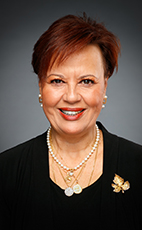Bill S-219
44th Parl. 1st Sess.
December 13, 2022
- Royal assent received
- Read Bill |
- Government Page
- This bill designates January 4th as "National Ribbon Skirt Day" in Canada. The ribbon skirt is a symbol of Indigenous womanhood, culture, and connection to the Earth. This bill aims to honor and recognize the importance of Indigenous culture and traditions, as well as promote understanding and celebrate diversity.
- H1
- H2
- H3
- S1
- S2
- S3
- RA
- Yea
- Nay

- Dec/13/22 2:00:00 p.m.
- Re: Bill S-219
The Hon. the Speaker informed the Senate that a message had been received from the House of Commons returning Bill S-219, An Act respecting a National Ribbon Skirt Day, and acquainting the Senate that they had passed this bill without amendment.
42 words
- Hear!
- Rabble!
- Hear!
- Rabble!
- Dec/9/22 1:52:59 p.m.
- Watch
- Re: Bill S-219
109 words
All Topics
- Hear!
- Rabble!
- Dec/9/22 1:45:54 p.m.
- Watch
- Re: Bill S-219
993 words
All Topics
- Hear!
- Rabble!
- Dec/9/22 1:39:38 p.m.
- Watch
- Re: Bill S-219
922 words
All Topics
- Hear!
- Rabble!
- Dec/9/22 1:32:26 p.m.
- Watch
- Re: Bill S-219
...something that our community and our ladies have been wearing in ceremonies. It represents a lot of issues with regard to what our people have been going through, with murdered and missing women, suicide and a lot of the addictions that are in our community. It's a way of us coming together and healing.
We were immediately working on solutions.... I remember how we were speaking about faith and belief. I remember speaking about the coat of many colours, and how the Creator made such a wondrous variety of people that we might have fellowship and be close together, learn each other's ways, learn to be tolerant of each other and love each other. These are all values that my family stands very firmly on. We have to be the change that we want to see in the world.
I think the advocacy that my daughter displayed was definitely through the hand of the Creator. Nothing is by mistake, and the divine nature of what's going on here shows that the Lord is in all things and guiding us all here today to do the right thing and show some unity and some respect and to realize that our mistakes of the past can be righted and that we need to do the best thing for the youth of Canada now. I believe that's what we're doing today.
1112 words
All Topics
- Hear!
- Rabble!
- Dec/9/22 1:30:47 p.m.
- Watch
- Re: Bill S-219
180 words
All Topics
- Hear!
- Rabble!
- Dec/9/22 1:29:57 p.m.
- Watch
- Re: Bill S-219
105 words
All Topics
- Hear!
- Rabble!
- Dec/9/22 1:29:04 p.m.
- Watch
- Re: Bill S-219
142 words
All Topics
- Hear!
- Rabble!
- Dec/9/22 1:27:51 p.m.
- Watch
- Re: Bill S-219
152 words
All Topics
- Hear!
- Rabble!
- Dec/9/22 1:21:05 p.m.
- Watch
- Re: Bill S-219
This bill will create a forum for dialogue within which we can explore the dark side of Canadian history in ways that do not dishearten or shame, but rather inspire us to enact a process of reconciliation for ourselves, both within our communities and the wider Canadian society.
Ribbon skirts themselves are meant to be worn, meant to be danced in, each skirt fashioned with uniqueness, a sign of pride, spirituality, taking back our spirit and making ourselves visible, meant to empower us to be seen. The ribbon skirt will continue our healing and will continue to transmit our history. It is a way to give voice. As we collectively wear our dresses, we gather strength.
This is not just a national day; it is also a day for us to say that our identity will no longer be disrespected. We, women, want respect for our daughters and sisters, who express their identity by wearing their skirt. When we wear a skirt, we are also carriers of life. We, women, are directly connected to mother earth and to all her strength and splendour. She is our nourishing mother.
Bella is brave because she's a small little girl who likes to trap rabbits with her dad and wear sweatpants and go into the woods. It was hard for her to put on that skirt. Sometimes she feels like her skin is a little bit pale to be feeling like a native person, but in her heart she's anishinaabekwe. Her culture and her ceremony give her that, and her ancestry.
I told her: “You wear that with pride. That's where you come from. Your Auntie Farrah Sanderson made that for you, and it comes from all the hard work from your ancestors who worked so hard to keep those traditions alive.”
1253 words
All Topics
- Hear!
- Rabble!
- Dec/9/22 1:20:00 p.m.
- Watch
- Re: Bill S-219
17 words
All Topics
- Hear!
- Rabble!
- Dec/5/22 3:23:03 p.m.
- Watch
- Re: Bill S-219
70 words
All Topics
- Hear!
- Rabble!
- Nov/24/22 5:35:11 p.m.
- Watch
- Re: Bill S-219
71 words
All Topics
- Hear!
- Rabble!
- Nov/24/22 5:32:55 p.m.
- Watch
- Re: Bill S-219
506 words
All Topics
- Hear!
- Rabble!
- Nov/24/22 5:22:42 p.m.
- Watch
- Re: Bill S-219
My name is Isabella Susanne Kulak and I would like to start off by telling you what the ribbon skirt means to me. The ribbon skirt represents strength, resiliency, cultural identity and womanhood. When I wear my ribbon skirt I feel confident and proud to be a young indigenous girl.
When I was 8 years old I was gifted my very own ribbon skirt from my auntie.... I wore it with pride and honour to my traditional ceremonies and pow wows. On December 18, 2020 it was formal day at Kamsack Comprehensive Institute where I attend school, so I chose to wear my ribbon skirt just like my older sister Gerri. When I got to school a teacher assistant commented on it and said it didn’t even match my shirt and maybe next formal day I should wear something else like another girl was wearing and pointed at her. Those words made me feel pressured to be someone I am not. I eventually took off my skirt as I felt shamed.
Today I no longer feel shamed and I feel proud and powerful enough to move mountains because I know that people from around the world are standing with me. I am very grateful to be Canadian, to be Indian and to represent my people by wearing my ribbon skirt proudly! Thank you to Senator McCallum and to all the people who supported me from around the world, from Canada and from all the First Nations across the nations of the earth.
Sincerely Isabella
1387 words
All Topics
- Hear!
- Rabble!
- Nov/24/22 5:12:40 p.m.
- Watch
- Re: Bill S-219
1000 words
All Topics
- Hear!
- Rabble!
- Nov/24/22 5:02:27 p.m.
- Watch
- Re: Bill S-219
1480 words
All Topics
- Hear!
- Rabble!
- Nov/24/22 4:52:22 p.m.
- Watch
- Re: Bill S-219
My name is Isabella Susanne Kulak and I would like to start off by telling you what the ribbon skirt means to me. The ribbon skirt represents strength, resiliency, cultural identity and womanhood. When I wear my ribbon skirt I feel confident and proud to be a young indigenous girl.
When I was 8 years old I was gifted my very own ribbon skirt from my auntie Farrah Sanderson. I wore it with pride and honor to my traditional ceremonies and pow wow's. On December 18th 2020 it was formal day at Kamsack Comprehensive Institute where I attend school, so I chose to wear my ribbon skirt just like my older sister Gerri. When I got to school a teacher assistant commented on it and said it didn't even match my skirt and maybe next formal day I should wear something else like another girl was wearing and pointed at her.
Today I no longer feel shamed and I feel proud and powerful enough to move mountains because I know that people from around the world are standing with me. I am very grateful to be Canadian, to be Indian and to represent my people by wearing my ribbon skirt proudly! Thank you to Senator McCallum and to all the people who supported me from around the world, from Canada and from all the First Nations across the nations of the earth.
On behalf of Cote First Nation, we are honored to have January 4th as National Ribbon Skirt Day across our great Nation. Bella Kulak has demonstrated the importance of sharing our culture to other nations. Our First Nations, Metis, Inuit women are a symbol of life givers and their resilience in looking after the home fires is our strength to move forward. We thank Senator McCallum for bringing forward such a recognition and encourage all Parliamentarians to offer their support for this bill in the year of Truth and Reconciliation. Meegwetch from the Saulteaux First Nations of Treaty 4 Territory.
[T]his bill aims to provide social justice for Bella and other young Indigenous youth who must struggle against racism, colonialism and gender violence in their day-to-day lives. By keeping this request for a national day of recognition situated within a framework generated from and led by the Cote reserve, it ensures that the families' and communities' tradition and intergenerational knowledge is secure while they're navigating modern Indigenous struggles. This also helps to resist the colonial images of Indigenous women, girls and transgender peoples. The acts of resistance by women — including mothers, aunts, grandmothers, sisters and friends — against ongoing violence and colonialism is very important, as their resistive acts are models for young Indigenous girls. They are acts against cultural genocide. Both mother and daughter are no longer willing to leave their spirits at the door and are ready to take that challenge to a different level that is bringing ceremony to everyday living, not only in their home but taking it to the outside world.
1354 words
All Topics
- Hear!
- Rabble!
- Oct/18/22 6:56:03 p.m.
- Watch
- Re: Bill S-219
30 words
All Topics
- Hear!
- Rabble!











